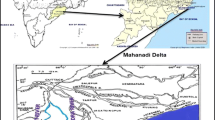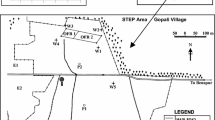Abstract
This paper reviews, compiles and comprehensively analyzes spatial variations in hydrogeologic characteristics of shallow and deep groundwater aquifers in Kathmandu Valley. To estimate transmissivity (T) (and then hydraulic conductivity) as a function of specific capacity (SC), an empirical relationship between T and SC is developed for shallow and deep aquifer. The results show that T and SC are log linearly related by an equation T = 0.8857(SC)1.1624 [R 2 = 0.79] in shallow and T = 1.1402(SC)1.0068 [R 2 = 0.85] in deep aquifer. The estimated T ranges from 163 to 1,056 m2/day in shallow aquifer and 22.5 to 737 m2/day in deep aquifer. Finally, mapping of spatial distribution in hydrogeologic characteristics (thickness, T, hydraulic conductivity and storage coefficient) in shallow and deep aquifers are accomplished using ArcGIS9.2 and such maps would be useful in delineating potential areas for groundwater development and simulating groundwater flow in the aquifer system.







Similar content being viewed by others
References
Acres International (2004) Optimizing water use in Kathmandu Valley (ADB-TA) project, final report. Submitted to Government of Nepal, Ministry of Physical Planning and Works, Acres International in association with Arcadis Euroconsult Land and Water Product Management Group, East Consult (P) Ltd. and Water Asia (P) Ltd
Binnie and Partners (1973) Groundwater investigations, Kathmandu water supply and sewerage scheme. A report submitted to the Government of Nepal
Chapagain SK, Pandey VP, Shrestha S, Nakamura T, Kazama F (2009) Assessment of deep groundwater quality in Kathmandu Valley using multivariate statistical techniques. Water Air Soil Pollut. 210(1–4):277–288. doi:10.1007/s11270-009-0249-8
Chettri M, Smith GD (1995) Nitrate pollution in groundwater in selected districts of Nepal. Hydrogeology 3:71–76
Dongol GMS (1985) Geology of the Kathmandu fluvial lacustrine sediments in the light of new vertebrate fossil occurrences. J Nepal Geol Soc 3:43–57
Dongol GMS (1987) The stratigraphic significance of vertebrate fossils from the quaternary deposits of the Kathmandu Basin, Nepal. Newslett Stratigr 18(1):21–29
ENPHO (Environment and Public Health Organization) (1999) Monitoring of groundwater quality in the Kathmandu Valley Nepal, a report submitted to Ministry of population and Environment, HMG Nepal
Gurung JK, Ishiga H, Khadka MS, Shrestha NR (2007) The geochemical study of fluvio-lacustrine aquifers in the Kathmandu basin (Nepal) and the implications for the mobilization of arsenic. Environ Geol 52(3):503–517. doi:10.1007/s00254-006-0483-y
Hamm SY, Cheong JY, Jang S, Jung CY, Kim BS (2005) Relationship between transmissivity and specific capacity in the volcanic aquifers of Jeju Island, Korea. J Hydrol 310(2005):111–121
Huntley D, Nommensen R, Steffey D (1992) The use of specific capacity to assess transmissivity in fractured-rock aquifer. Ground Water 30(3):396–402
Jalludin M, Razack M (2004) Assessment of hydraulic properties of sedimentary and volcanic aquifer systems under arid conditions in the Republic of Djibouti (Horn of Africa). Hydrogeology 12:159–170
Jha MG, Khadka MS, Shrestha MP, Regmi S, Bauld J, Jacobson G (1997) The assessment of groundwater pollution in the Kathmandu Valley, Nepal: report on Joint Nepal–Australia Project 1995–1996. Australian Geological Survey Organization, Canberra, pp 1–64
JICA (1990) Groundwater management project in Kathmandu Valley. Final report, main report and supporting reports, November 1990
KC Keshab (2003) Optimizing water use in Kathmandu Valley (ADB TA-3700), final draft report on groundwater/hydrogeology in Kathmandu Valley, January 2003
Khadka MS (1993) The groundwater quality situation in alluvial aquifers of the Kathmandu Valley, Nepal. AGSO J Aust Geol Geophys 14:207–211
Kharel BD, Shrestha NR, Khadka MS, Singh VK, Piya B, Bhandari R, Shrestha MP, Jha MG, Munstermann D (1998) Hydrogeological conditions and potential barrier sediments in the Kathmandu Valley. Final report of the technical cooperation project—environment geology, between Kingdom of Nepal, HMG and Federal Republic of Germany
Mace RE (1997) Determination of transmissivity from specific capacity tests in a karst aquifer. Ground Water 35(5):738–742
Mace RE, Smyth RC, Xu L, Liang J (2000) Transmissivity, hydraulic conductivity and storativity of the Carrioz–Wilcox aquifer in Texas. A technical report prepared for Texas Water Development Board. Bureau of Economy and Geology, The University of Texas at Austin, Texas
Metcalf and Eddy (2000) Urban water supply reforms in the Kathmandu Valley (ADB TA Number 2998-NEP), completion report, volume I and II—executive summary, main report and annex 1 through 7. Metcalf and Eddy, Inc. with CEMAT Consultants Ltd., 18 February 2000
Pandey VP, Chapagain SK, Kazama F (2010) Evaluation of groundwater environment of Kathmandu Valley. Environ Earth Sci 60(6):1329–1342. doi:10.1007/s12665-009-0263-6
Paudel MR, Kuwahara Y, Sakai H (2004) Changes in mineral composition and depositional environment recorded in the present and past basin-fill sediments of the Kathmandu Valley, central Nepal. Himal J Sci 2:222–223
Razack M, Huntley D (1991) Assessing transmissivity from specific capacity in a large and heterogeneous alluvial aquifer. Ground Water 29(6):856–861
Sakai H (2001) Stratigraphic division and sedimentary facies of the Kathmandu Basin group, Central Nepal. J Nepal Geol Soc 25 (Special Issue):19–32
Sakai H, Fujii R, Kuwahara Y, Upreti BN, Shrestha SD (2001) Core drilling of the basin-fill sediments in the Kathmandu Valley for palaeoclimatic study: preliminary results. J Nepal Geol Soc 25 (Special Issue):9–18
Shrestha OM, Koirala A, Karmacharya SL, Pradhanaga UB, Pradhan R, Karmacharya R (1998) Engineering and environmental geological map of Kathmandu Valley. Department of Mines and Geology, HMG Nepal
Yoshida M, Gautam P (1988) Magnetostratigraphy of Plio-Pleistocene lacustrine deposits in the Kathmandu Valley, central Nepal. Proc Ind Natl Sci Acad 54(3):410–417
Yoshida M, Igarashi Y (1984) Neogene to quaternary lacustrine sediments in the Kathmandu Valley, Nepal. J Nepal Geol Soc 4:73–100
Acknowledgments
The authors would like to acknowledge Japanese Government (Monbukagakusyo: MEXT), the GCOE Program of University of Yamanashi for supporting this study; and several organizations in Nepal (e.g. Groundwater Research and Development Project/Department of Irrigation, Melamchi Drinking Water Supply Project-Kathmandu, CEMAT Consulting Company, NISAKU drilling company-branch office Kathmandu, National drilling company-Kathmandu, Sagarmatha drilling company, Department of Mines and Geology-Kathmandu, Integrated Rural Development Services Nepal) for kindly providing data and information.
Author information
Authors and Affiliations
Corresponding author
Electronic supplementary material
Below is the link to the electronic supplementary material.
Rights and permissions
About this article
Cite this article
Pandey, V.P., Kazama, F. Hydrogeologic characteristics of groundwater aquifers in Kathmandu Valley, Nepal. Environ Earth Sci 62, 1723–1732 (2011). https://doi.org/10.1007/s12665-010-0667-3
Received:
Accepted:
Published:
Issue Date:
DOI: https://doi.org/10.1007/s12665-010-0667-3




